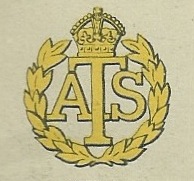Auxiliary Territorial Service
| Auxiliary Territorial Service | |
|---|---|

Cap Badge of the Auxiliary Territorial Service
|
|
| Active | 9 September 1938 – 1 February 1949 |
| Allegiance |
|
| Branch |
|
| Size | 190,000 |
| Commanders | |
| Ceremonial chief | Princess Mary (Honorary Controller-Commandant) |
The Auxiliary Territorial Service (ATS; often pronounced as an acronym) was the women's branch of the British Army during the Second World War. It was formed on 9 September 1938, initially as a women's voluntary service, and existed until 1 February 1949, when it was merged into the Women's Royal Army Corps.
The ATS had its roots in the Women's Auxiliary Army Corps (WAAC), which was formed in 1917 as a voluntary service. During the First World War its members served in a number of jobs including clerks, cooks, telephonists and waitresses. The WAAC was disbanded after four years in 1921.
Prior to the Second World War, the government decided to establish a new Corps for women, and an advisory council, which included members of the Territorial Army (TA), a section of the Women's Transport Service (FANY) and the Women's Legion, was set up. The council decided that the ATS would be attached to the Territorial Army, and the women serving would receive two thirds the pay of male soldiers.
All women in the army joined the ATS except for nurses, who joined Queen Alexandra's Imperial Military Nursing Service (QAIMNS), and medical and dental officers, who were commissioned directly into the Army and held army ranks, and those remaining in the FANY, known as Free FANYs.
The first recruits to the ATS were employed as cooks, clerks and storekeepers. At the outbreak of the Second World War, 300 ATS members were billeted to France. As the German Army advanced through France, the British Expeditionary Force was driven back towards the English Channel. This led to the evacuation of troops from Dunkirk in May 1940, and some ATS telephonists were among the last British personnel to leave the country.
As more men joined the war effort, it was decided to increase the size of the ATS, with numbers reaching 65,000 by September 1941. Women between the ages of 17 and 43 were allowed to join, although these rules were relaxed in order to allow WAAC veterans to join up to the age of 50. The duties of members were also expanded, seeing ATS orderlies, drivers, postal workers and ammunition inspectors.
...
Wikipedia
